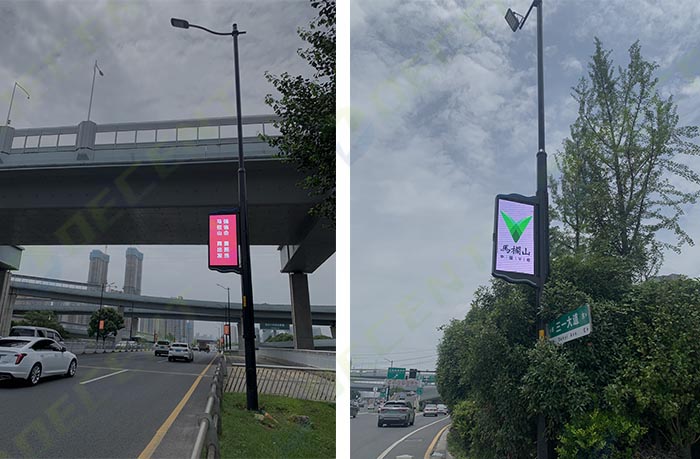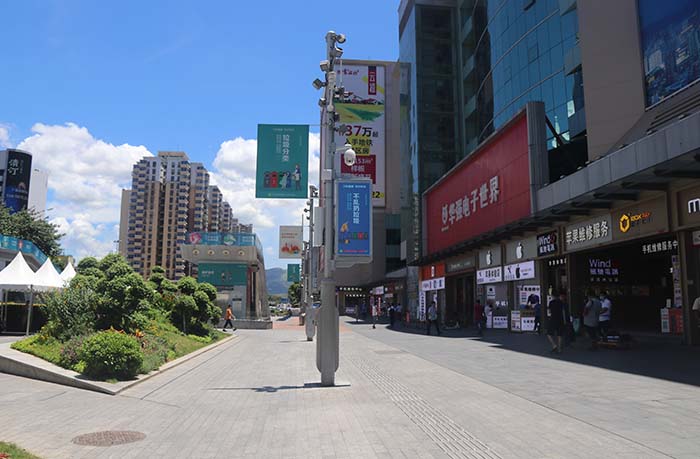



With the rapid growth of smart cities and the ongoing advancements in technology, light pole led display have become a key component in urban infrastructure. These outdoor display devices play an important role in information dissemination and urban landscape enhancement. Given their increasing presence in streets, squares, parks, and other public spaces, LED light pole screens often rely on post-maintenance design. But why is this method preferred for these displays? This article explains the advantages of post-maintenance and why it is the optimal choice for LED pole screens.
Post-maintenance refers to a design where maintenance and repairs can be performed from the back of the screen. In contrast to front-maintenance designs, where technicians access the screen from the front, post-maintenance allows for repairs without needing to dismantle the entire device. This design is particularly suited for large outdoor LED screens, where access may be limited and operational efficiency is critical.

LED pole screens are commonly installed in challenging outdoor environments. These devices face many factors that can affect their performance and longevity. From extreme weather conditions like heavy rain and snow to potential physical damage from the public, these displays must be built to withstand a variety of risks.
Here are the main reasons post-maintenance design is used for light pole led display:
– Space Efficiency: One of the most notable advantages of post-maintenance is that it reduces the thickness of the LED screen. With the maintenance elements placed at the back of the screen, designers can ensure that the display remains compact and lightweight. This not only makes the screen easier to install but also allows for better integration into the urban landscape.
– Improved Aesthetics: Urban spaces are often designed with an eye toward visual appeal, and bulky displays can detract from the overall look of a city street or park. By using post-maintenance design, the thickness of the screen is minimized, helping the LED pole screen blend seamlessly into its surroundings without compromising its functionality.

– Better Brightness and Viewing Angles: With post-maintenance design, the display can maintain a slimmer profile while still offering high brightness and wide viewing angles. This is essential in urban environments, where the screen needs to be visible from various distances and angles. The post-maintenance method enables the screen to offer superior visibility without needing to make design sacrifices that could affect performance.
– Maintaining Aesthetic Integrity: A front-maintenance design typically increases the thickness of the display, which can impact its visual appeal. On the other hand, post-maintenance ensures that the aesthetics of the display remain intact while also ensuring optimal brightness and clarity. This is crucial for LED light pole screens, as they are often used for outdoor advertising, public information, and city branding.
– Weather Resistance: Outdoor displays are exposed to harsh environmental factors, including rain, snow, dust, and extreme temperatures. The post-maintenance design helps protect the internal electronic components of the screen. By having a maintenance access point at the rear, the screen’s casing can be sealed more effectively, reducing the risk of water or dust entering the display and causing damage.
– Better Protection from Damage: In urban environments, light pole LED display are at risk of physical damage, whether due to accidental collisions or vandalism. The post-maintenance design enhances the durability of the screen by providing a robust structure that is less likely to be damaged in such events. Moreover, the rear access ensures that maintenance can be performed quickly without disrupting the screen’s operation.

– Faster Repairs: When maintenance is required, the post-maintenance method allows technicians to access and repair individual modules or components quickly from the back of the screen. This reduces the need for complex disassembly and makes repairs faster and more efficient. As a result, the screen experiences less downtime, which is particularly important in high-traffic areas where the screen serves as a vital information or advertising tool.
– Modular Design Compatibility: Post-maintenance is also compatible with modular design systems. Modular systems allow individual components of the screen (such as LED modules, power supplies, and control boards) to be replaced independently. This modularity means that technicians can address issues more efficiently, replacing faulty parts without needing to replace the entire screen.
– Integration with Smart Features: As technology evolves, LED pole screens are becoming smarter. Post-maintenance design supports the integration of advanced technologies like remote monitoring and diagnostic systems. These systems can detect potential issues early, allowing technicians to address problems before they become major failures. With post-maintenance, technicians can easily access the components that require attention without disrupting the overall operation of the screen.
– Remote Monitoring: Many modern LED screens now come equipped with remote monitoring capabilities, enabling technicians to monitor performance in real time. This allows for proactive maintenance and ensures the screen remains operational without requiring frequent physical intervention. The post-maintenance approach facilitates easy integration with these smart monitoring systems.

– Safety for Users and Technicians: Post-maintenance design enhances the safety of both the public and maintenance personnel. Since maintenance is conducted from the back, technicians can access the components without having to risk working in high-traffic or dangerous front-facing locations. This also reduces the risk of accidental exposure to high-voltage components during maintenance.
– Longevity of the Equipment: By providing better weather resistance, easier repairs, and more efficient maintenance, the post-maintenance method can extend the lifespan of the pole LED screen. With fewer issues related to weather damage or operational inefficiency, these screens remain effective for a longer period, making them a more cost-effective solution in the long run.
The post-maintenance design of light pole led display screen offers numerous advantages that align with the needs of modern urban environments. This approach ensures that the displays remain slim and aesthetically pleasing, while also enhancing their durability, ease of maintenance, and performance. With the growing reliance on outdoor digital signage in smart cities, post-maintenance is set to remain a key feature in the development and application of LED pole screens. As technology continues to advance, the integration of post-maintenance design will further optimize both the installation and upkeep of these vital urban devices.
If you need an LED solution, you can contact us!
The pictures in the article are all our cases
contact us
Stay up-to-date with our new product releases and latest news articles. DECENT Technology is a leading global supplier of LED display screens, providing customers worldwide with comprehensive solutions for the research and development, manufacturing, engineering installation, and after-sales service of high-end LED display equipment and display control systems. At present, it has developed into a national high-tech enterprise with over 1300 employees and more than 400 authorized national patents. The company has successively obtained safety production license, steel structure construction qualification, system integration qualification, third level professional contracting for building mechanical and electrical installation engineering, and second level professional contracting for electronic and intelligent engineering.
DECENT Technology is positioned as "core technology oriented" and has deeply cultivated and worked in the LED industry. It has established numerous marketing centers, offices, and after-sales service outlets worldwide. The company's products are distributed in more than 200 countries and regions, and has accumulated over 40000 classic cases. The strong comprehensive strength has made DECENT Technology the preferred brand among the Fortune Global 500 companies such as Sinopec, PetroChina, Tencent, Alibaba, Huawei, and Abbott.
Since its establishment, DECENT Technology has accumulated 10 industry-leading technologies and 43 innovative "black technology" technologies; And we have developed six product lines, including professional display, universal display, conference display, commercial display, outdoor led display, and rental display, which are applied in multiple scenarios such as command and monitoring, commercial display retail, broadcasting and broadcasting, outdoor advertising, sports events, and stage performances. The product quality maintains a leading position in the industry.
In the future, DECENT Technology will continue to adhere to the business philosophy of "product+service" and the corporate values of "innovation, sunshine, struggle, and gratitude", continuously moving towards higher technology, better services, and harder quality, committed to providing professional LED display system solutions for every customer.
DECENT Technology is a leading global supplier of LED display screens, providing customers worldwide with comprehensive solutions for the research and development, manufacturing, engineering installation, and after-sales service of high-end LED display equipment and display control systems. At present, it has developed into a national high-tech enterprise with over 1300 employees and more than 400 authorized national patents. The company has successively obtained safety production license, steel structure construction qualification, system integration qualification, third level professional contracting for building mechanical and electrical installation engineering, and second level professional contracting for electronic and intelligent engineering.
DECENT Technology is positioned as "core technology oriented" and has deeply cultivated and worked in the LED industry. It has established numerous marketing centers, offices, and after-sales service outlets worldwide. The company's products are distributed in more than 200 countries and regions, and has accumulated over 40000 classic cases. The strong comprehensive strength has made DECENT Technology the preferred brand among the Fortune Global 500 companies such as Sinopec, PetroChina, Tencent, Alibaba, Huawei, and Abbott.
Since its establishment, DECENT Technology has accumulated 10 industry-leading technologies and 43 innovative "black technology" technologies; And we have developed six product lines, including professional display, universal display, conference display, commercial display, outdoor led display, and rental display, which are applied in multiple scenarios such as command and monitoring, commercial display retail, broadcasting and broadcasting, outdoor advertising, sports events, and stage performances. The product quality maintains a leading position in the industry.
In the future, DECENT Technology will continue to adhere to the business philosophy of "product+service" and the corporate values of "innovation, sunshine, struggle, and gratitude", continuously moving towards higher technology, better services, and harder quality, committed to providing professional LED display system solutions for every customer. Do you have any questions or requests?
Click below, we are happy to provide assistance. contact us